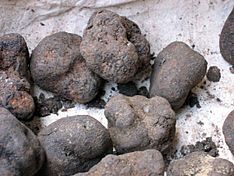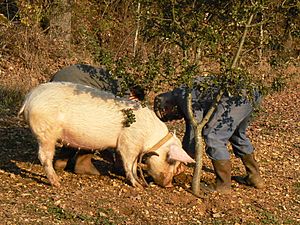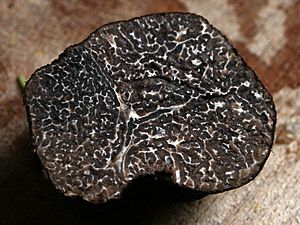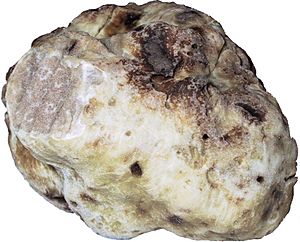Truffle facts for kids
Quick facts for kids Truffle |
|
|---|---|
 |
|
| Scientific classification | |
| Kingdom: | |
| Division: | |
| Subphylum: |
Pezizomycotina
|
| Class: |
Pezizomycetes
|
| Order: |
Pezizales
|
| Family: | |
| Genus: |
Tuber
|
A truffle is a special type of mushroom that grows underground. It's actually the part of the fungus that produces spores, which are like tiny seeds. Animals that eat fungi, called fungivores, help spread these spores around.
Most truffles grow very close to trees. They have a special partnership with tree roots called mycorrhiza. This means they help each other grow! Truffles are highly valued in cooking because they add a unique and strong flavor to food.
There are hundreds of different kinds of truffles. However, only a few, mostly from the Tuber group, are considered very special and expensive. An old French food expert once called them "the diamond of the kitchen." They are used in fancy cooking around the world, especially in Europe.
Contents
Types of Truffles
Truffles come in different types, each with its own special qualities. The most famous ones are the black truffle and the white truffle.
Black Truffles
The "black truffle" is also known as the "black Périgord truffle" (Tuber melanosporum). It gets its name from the Périgord region in France. This truffle only grows with oak trees.
You can find black truffles in late autumn and winter. They can grow up to 7 centimeters (about 3 inches) wide and weigh up to 100 grams (about 3.5 ounces). Most black truffles come from Europe, with France, Spain, and Italy producing the most. Small amounts are also found in Slovenia, Croatia, and even Australia.
A long time ago, in 1900, France produced a lot of black truffles, about 1,000 metric tons each year. Today, production is much smaller, around 20 metric tons per year. About 80% of French black truffles come from southeastern France. The biggest truffle markets are in Richerenches and Lalbenque, France. These markets are busiest in January when the truffles smell the strongest. Black truffles can be quite expensive, sometimes selling for thousands of euros per kilogram.
White Truffles
The "white truffle" is also called Alba madonna or Tuber magnatum. It mostly comes from the Piedmont region in northern Italy, especially near the city of Alba. You can also find it in Croatia, in the Motovun forest.
White truffles grow with oak, hazel, poplar, and beech trees. They are found in autumn. These truffles can be quite large, sometimes reaching 12 centimeters (about 5 inches) wide and weighing up to 500 grams (about 1 pound). However, they are usually smaller. The inside of a white truffle is pale cream or brown with white lines. Like black truffles, Italian white truffles are highly valued and very expensive.
The white truffle market in Alba is busiest in October and November. In 2009, a 1.6-pound white truffle sold for $150,000 at a festival! White truffles can sell for over €10,000 per kilogram.
One of the biggest truffles ever found was a white truffle weighing 1.31 kilograms (about 2.9 pounds). It was found in Croatia by Giancarlo Zigante and his dog Diana, and it made it into the Guinness World Records. In 2007, a single white truffle weighing 1.5 kilograms (about 3.3 pounds) sold for a record $330,000 at an auction!
How Truffles Are Found


Finding truffles in the wild is a special skill. People almost always use specially trained animals to help them. Traditionally, pigs were used, but more recently, dogs have become popular.
The Lagotto Romagnolo is the only dog breed officially known for sniffing out truffles. However, almost any dog can be trained to do this.
| Truffle Pig | Truffle Dog |
|---|---|
| Has a very strong sense of smell | Has a very strong sense of smell |
| Naturally knows how to find truffles | Needs to be trained to find truffles |
| Tends to eat the truffles it finds | Easier to control and less likely to eat truffles |
Female pigs are naturally good at finding truffles because truffles contain a special smell that is similar to a scent male pigs produce. This smell strongly attracts female pigs.
In Italy, using pigs to hunt truffles has been against the law since 1985. This is because pigs can damage the underground network of the fungus, called mycelia, when they dig. This damage can reduce how many truffles grow in that area for several years.
Growing Truffles
Truffles can be grown on farms, but it's not an easy process. The two World Wars in Europe made it harder to grow truffles, and changes in how land is used also reduced the areas where they could grow.
Today, people are working to grow truffles in new places, like Australia and New Zealand. This helps make sure there are enough truffles for everyone to enjoy.
Images for kids
-
Black truffle (Tuber melanosporum)
-
Statue of Joseph Talon in Saint-Saturnin-lès-Apt
-
A truffle market in Carpentras, France
-
A trained truffle hunting pig in Gignac, Lot, France
See also
 In Spanish: Trufa para niños
In Spanish: Trufa para niños














